- Science Castle Research Fund
- Announcements for middle and high school students
- Information for Teachers
- Digest of Oral Presentations
- Research Tips
Why do decorative flowers remain after winter? The Mystery of the Gaku Hydrangea [Science Castle 2023 Kanto Digest].
2024.06.04![Why do decorative flowers remain after winter? Approaching the Mystery of Gaku Hydrangea [Science Castle 2023 Kanto Digest]</trp-post-container](https://s-castle.com/wp-content/uploads/sites/14/2024/06/9b8f96efa11ac0cacdfb0aaa2182b2a7.jpg)
We will provide a digest of Science Castle, an academic conference for junior and senior high school students at which the next generation of researchers are active, and the excitement of the event. In this issue, we report on the presentation by Kosei Miyamoto, a second-year student at Urawa Jitsugyo Gakuen Junior & Senior High School, who received the Keio University Prize for his oral presentation at the Science Castle 2023 Kanto Conference!
Affiliation and grade are as of the time of the announcement.
Great research can only come from passionate people.
I am Kosei Miyamoto from Urawa Jitsugyo High School. Pleased to meet you. I met Apple founder Steve Jobs in a book when I was in the second grade of junior high school. Since then, I have loved him as much as my research. He said, "Great products can only come from passionate people. So, I have replaced the word "product" with a word that is close to my heart, "research," with the belief that great research can only come from passionate people. For this presentation, I worked hard in preparation, watching Steve Jobs' presentation many times. With passionate emotions, we can change the world. We can impact the universe. There are many people around my laboratory who are doing research using advanced research equipment and special chemicals. In the midst of all this, I decided that I should cherish a small but simple question I had in the garden of my grandmother's house when I was in the sixth grade. Over the course of my high school years, I have been researching the "mystery of how the decorative flowers of gaku hydrangea remain warped for a long period of time.
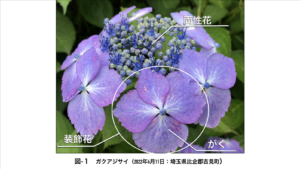
I want to unravel the mystery surrounding the beautiful decorative flowers.
Flowers are important reproductive organs of seed plants and are generally arranged from the center in the order of pistil, stamen, petal, and clasp. The flower is usually a small, unobtrusive organ, but in the case of the gaku hydrangea, the flower is an exception in that it has developed into a large, colorful organ known as a beautiful decorative flower. Ornamental flowers have been implicated in the influx of insects, and in the case of gaku hydrangea, the phenomenon of warping has been reported, as shown in Figure 2.
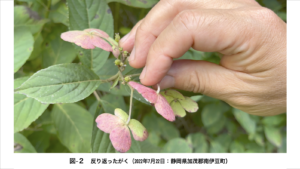
If we observe this by following the time of the year, we can see that the warped "kaku" tends to maintain its shape even around December, as shown in Figure-3. Here, I wondered, 'Why do they do this, when normal plants should form a "kudzu" only during the reproductive season? Then, I hypothesized that this recurved "stem" may have a role like a slide, expanding the dispersal area of seeds spilling out from the capsule of the bisexual flower.
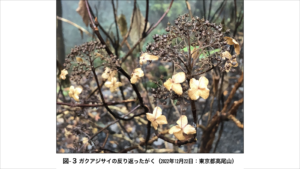
First, an experiment with a model
Unfortunately, at the time we began this experiment, it was not yet time to collect the seeds or the warped state of the "buds," so we began with a model experiment. The procedure is as follows. We will explain it with the help of a video.

First, prepare a domed dish, a disk, glass bead balls, a cut cloth, and a rag. Spray the surface with the cloth to prevent the beads from being repelled by the falling beads. Place the disk on top of the domed dish. First, we dropped about 180 beads of about 1 mm in diameter from a height of 2 cm without decorative flowers. The beads diffused as shown in Figure 4. Next, we also performed the experiment with decorative flowers. (If you watch the movie carefully, you can see that the beads that fell in the center of the dome hit one of the dishes of the dome and bounced back. The results are summarized in Figures 4 and 5, both of which show that the beads fell in a radial pattern. However, the model with decorative flowers in Figure 5 shows more pronounced seed dispersal.
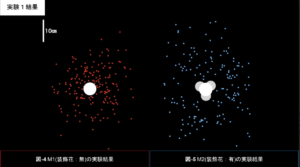
The effect is more visually confirmed when the data is superimposed as shown in Figure 6.
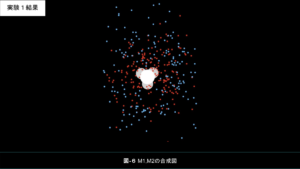
The bar graph also shows that the blue area with decorative flowers has a greater overall shift in travel distance to the right than the blue area with decorative flowers. The red area is without decorative flowers, but the area where both overlap is purple.

Finally, an experiment with the real thing! And...
So, when the time finally came to obtain the actual decorative flowers, we experimented by setting them up so that they were about 10 cm high, using the same technique as before.
The results are shown in Figure-10 with H1, without decorative flowers, and Figure-11 with H2, with decorative flowers. The superimposed image is in Figure-12, and both are radially distributed, as we could grasp from the model experiment we just performed. However, we can see that the presence of the decorative flower sends the beads farther away. When we convert the data, we can see that the beads with decorative flowers are also shifted to the right here.
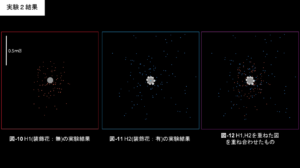
The surprising point is that H2, with decorative flowers, is 2.7 times larger than H1.
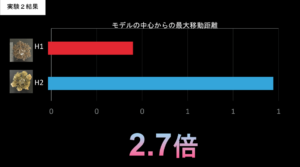
At this point, we had compiled some experimental data, but just before submitting the presentation to be presented today, we managed to obtain a small amount of seeds, so we conducted the third and final experiment.
The technique was similar to Experiment 2. At this time, for the first time, I was supremely excited to see and verify the seeds with my own hands and with my own eyes. Seeds in their young age have a structure of 1 mm in diameter with a rounded center and protuberances at both ends, as seen here under the microscope.
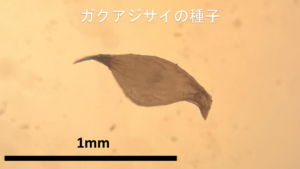
When dropped, the majority fell on the ground surface. However, a certain amount remained on the decorative flowers. I felt very betrayed by this.
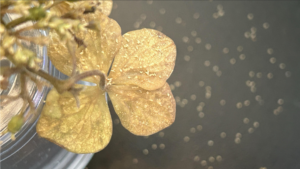
However, we thought this was another strategy of the gakuhydrangea. The first hypothesis, that the seeds bounce back on the decorative flowers, remains intact. However, we have revised our hypothesis that the seeds left on the decorative flowers are then stepped on so that they can be blown farther away by the wind. To confirm this hypothesis, I intend to replant the seeds collected in the field in an area where they can be observed, and to investigate and collect data on the location of germination of the seeds that were sprayed around March. I intend to continue this experiment in the future as I enter my college life. I will dedicate my university life to the research, so I would like to ask for your support. Thank you very much for your attention.
question and answer session
the heavens (taking) best care(Mitsui Chemicals, Inc.):
Thank you for your very interesting presentation. I have one question. Why did you focus on this gaku hydrangea, Mr. Miyamoto? You said it was somewhere nearby, at a relative's house, but why were you interested in the "warped" part?
Kosei Miyamoto:
When I was in the sixth grade, my grandmother grew other things in her garden with her, for example, blueberries and sunflowers. Among them, only the gaku hydrangea would not drop its leaves in the fall and winter. Seeing this, I wondered if this was really a good idea. And now that I joined the biology club, I undertook this experiment to solve my own question.
the heavens (taking) best care(Mitsui Chemicals, Inc.):
Did you initially focus on the leaves remaining? I wondered how long they would not drop the leaves.
Kosei Miyamoto:
You are right.
the heavens (taking) best care(Mitsui Chemicals, Inc.):
I thought the process of experimentation was very interesting.
Naoki Morishita (Nippon Ham Co., Ltd.):
Looking at the shape of the last seed, I think it is probably the kind of shape that would fly away in the wind. So, in addition to this experiment and hypothesis, I still think that the shape of the last seed is such that it is easily blown away by the wind. Perhaps the presence of the "bamboo" will make it sway and fly better against wind resistance, or it could go in a variety of other directions. I think it would be very interesting to conduct future experiments focusing on wind.
Kosei Miyamoto:
Thank you very much.
Yasuhiro Iida (Kanagawa Institute of Technology):
Some of the photos were taken in nature, how did you actually take them?
Kosei Miyamoto:
In fact, if you look at the date at the bottom of the image I showed you at the beginning, the end of the year, December 22, I checked the bisexual flowers in the image and the seeds were there.
Yasuhiro Iida (Kanagawa Institute of Technology):
I guess it could be wind, judging from the shape of the seed, but it could also be something that sticks to animals, like if you leave it long enough, it will stick to animals when they pass by.
Kosei Miyamoto:
The decorative flowers are very susceptible to wind in that they are large and well developed. So I am wondering if flowers have evolved with such a strategy so that they can maximize the "seeds stepping on the ornamental flowers" that I talked about when I deepened my hypothesis at the end.
Kenjiro Hanaoka (Keio University):
I wondered if wind and animal information was important, but one more thing. They did an experiment and found a 2.7-fold increase in the number of flowers between the hypothesis and the proof. 2.7-fold seems like a large number, but I wondered how much of an impact it would have in terms of increasing the number of flowers if it differed by that much.
Kosei Miyamoto:
The bisexual flowers release a large number of seeds, but if they all fall into the vicinity of the original plant body, they will compete with each other for soil nutrients and sunlight. In a sense, this would be an act of self-destruction. For example, dandelions use cotton wool to send their seeds far away, and in the same way, we believe that the seeds are kept from gathering too many friends nearby.
Kenjiro Hanaoka (Keio University):
I see. Thank you very much.
(*Honorifics omitted)
